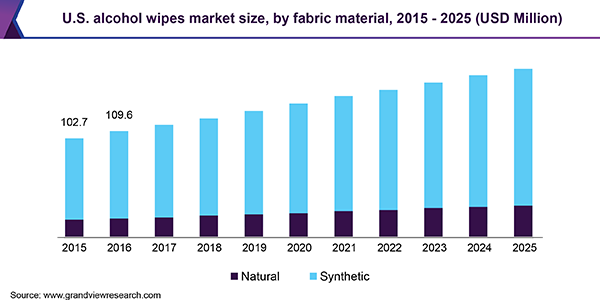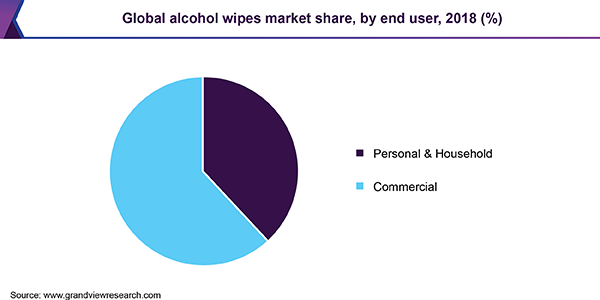- Home
- »
- Beauty & Personal Care
- »
-
Alcohol Wipes Market Size, Share, Global Industry Growth Report, 2025GVR Report cover
![Alcohol Wipes Market Size, Share & Trends Report]()
Alcohol Wipes Market Size, Share & Trends Analysis Report By Fabric Material (Natural, Synthetic), By End User (Commercial, Personal & Household), By Region, And Segment Forecasts, 2019 - 2025
- Report ID: GVR-3-68038-802-2
- Number of Report Pages: 80
- Format: PDF, Horizon Databook
- Historical Range: 2015 - 2017
- Forecast Period: 2019 - 2025
- Industry: Consumer Goods
Industry Insights
The global alcohol wipes market size was valued at USD 498.2 million in 2018 and is expected to expand at a CAGR of 5.3% from 2019 to 2025. The growth is attributed to the versatile application and high demand for the product from the healthcare industry. Alcohol is a very good solvent and it easily dissolves dirt, oil, and microorganisms. It is an effective disinfectant that offers instant drying. These properties of alcohol are anticipated to drive its adoption in wipes manufacturing.
Rising consumer awareness regarding hygiene is one of the major factors boosting the demand for alcohol wipes. Characteristics of the product such as affordability, packaging, performance, fragrance, eco-friendliness, fabric material, and texture influence consumers’ purchasing decisions. The efficiency of the product is changing the traditional ways of cleaning in commercial as well as personal and household segments, which in turn is anticipated to bode well for the market growth. Ease of carrying and usage during driving, trekking, traveling, and public places and outdoor activities are anticipated to bode well for the product demand.

Wet wipes with alcohol concentration above 60% fall under the category of alcohol wipes. Consumers use the product for pain relief in case of insect bites, minor burns, and scratches as alcohol disinfects the affected area and eases the pain. Isopropyl is a major ingredient in alcohol wipes, which helps prevent the growth of various microorganisms, such as diarrhea virus, hepatitis B and C, mycobacterium tuberculosis, and Human HIV-1. The wipes are also used for cleaning dust in homes and offices. They are also used to cleanse the skin off acne-causing bacteria. However, the product can cause increased oil production, dryness, and acne in the case of sensitive skin. This factor is anticipated to challenge the growth of the alcohol wipes market.
Wet wipes industry is facing challenges as the non-disposable wipes can clog drainage systems. In 2018, the U.K. government announced a ban on single used products including the wipes to avoid this issue as well as to save marine life. Stringent government regulations regarding product labeling to maintain transparency is anticipated to influence the market. Recently, Holland and Barrett, a U.K. based leading health retailer stopped selling wet wipes including alcohol wipes in its 800 stores in U.K. and Ireland. The company is replacing these products with sustainable and biodegradable wipes made of natural fibers such as cotton and wooden pulp. Growing demand for eco-friendly and disposable wipes is creating room for the new entrants in the market.
Fabric Material Insights
Synthetic fabric material held the largest market share in 2018 and is expected to continue leading over the forecasted period. Absorbance and softness of the fabric specifically designed for skin applications are driving the product demand. Synthetic alcohol wipes are made from Polypropylene (PP), rayon, and specialty materials such as bi-component fibers and nanofibers. These products are lightweight, heat resistant, highly absorbent, and soft. The softness of the fabric plays a major role in driving the commercial application of the product, especially for cleaning screens and delicate glass equipment, and gadgets.
The natural fabric material is estimated to register the fastest CAGR over the forecasted period owing to the biodegradable and eco-friendly nature of the product. Growing preference for green products is anticipated to encourage manufacturers to develop biodegradable and environmentally friendly products. Also, the demand for flushable wipes is anticipated to witness growth owing to stringent government regulations to boost the usage of biodegradable wipes.
End-User Insights
The commercial segment held the largest market share in 2018 and is expected to continue leading over the forecasted period. The growth is attributed to rising demand from the healthcare industry. High adoption of the product from hospitals and clinics to maintain hygiene in critical areas such as Intensive Care Units (ICUs) and Operation Theaters (OTs) is anticipated to bode well for the segment growth.

The food industry is expected to support market growth due to the rising need for the product to maintain hygiene and to prevent contamination in plants. Consumers prefer alcohol wipes in cylindrical packaging due to their enhanced durability. Personal and Household segment is also estimated to witness strong growth over the forecasted period, attributed to rising consumer consciousness regarding hygiene. Rising use of the product to clean furniture, ink, and oil stains and household appliances that cannot be cleaned with water or wet cloths is anticipated to fuel the growth.
Regional Insights
North America held the largest market share in 2018 and is expected to continue holding a significant share over the forecasted period owing to the growing product demand for personal hygiene and household cleaning. In North America, the U.S. alone accounted for approximately 60% of the market in 2018 owing to increasing demand for wipes with sanitizing and antiseptic properties.
Asia Pacific is estimated to expand at the fastest CAGR over the forecast period, owing to rising consumer awareness and developing the healthcare industry. Increasing healthcare expenditure in both public and private sectors is projected to bode well for the regional demand for alcohol wipes. Increasing spending power and disposable income in developing economies such as India and China are supporting regional market growth.
Alcohol Wipes Market Share Insights
Major market players include Cardinal Health Inc.; CleanFinity Brands; Pal International Ltd.; Robinson Healthcare Ltd.; The Clorox Co.; GAMA Healthcare Ltd.; Whitminster International; Diamond Wipes International Inc.; Clarisan; and 3M Company. The market is fragmented owing to the presence of a large number of regional manufacturers. Many players are introducing new products such as alcohol wipes with fragrance to attract more consumers. For instance, Swago launched its cologne-scented wipes for consumers who do not want to carry perfume bottles.
Rising demand for flushable and disposable wipes is also expected to drive the adoption of natural materials to produce alcohol wipes. Rising demand for cost-effective products is projected to drive innovation in the product manufacturing process. The key players focus on product innovation and control the pricing.
Report Scope
Attribute
Details
The base year for estimation
2018
Actual estimates/Historical data
2015 - 2017
Forecast period
2019 - 2025
Market representation
Revenue in USD Million & CAGR from 2019 to 2025
Regional scope
North America, Europe, Asia Pacific, Central & South America & MEA
Country scope
U.S., U.K., Germany, China, Japan, India, Brazil
Report coverage
Revenue forecast, company share, competitive landscape, growth factors and trends
15% free customization scope (equivalent to 5 analyst working days)
If you need specific information, which is not currently within the scope of the report, we will provide it to you as a part of customization
Segments Covered in the ReportThis report forecasts revenue growth at global, regional, and country levels and provides an analysis of the latest industry trends and opportunities in each of the sub-segments from 2015 to 2025. For this study, Grand View Research has segmented the global alcohol wipes market report based on the fabric material, end-user, and region:
-
Fabric Material Outlook (Revenue, USD Million, 2015 - 2025)
-
Natural
-
Synthetic
-
-
End-User Outlook (Revenue, USD Million, 2015 - 2025)
-
Personal & Household
-
Commercial
-
-
Regional Outlook (Revenue, USD Million, 2015 - 2025)
-
North America
-
The U.S.
-
-
Europe
-
Germany
-
The U.K.
-
-
Asia Pacific
-
China
-
Japan
-
India
-
-
Central & South America
-
Brazil
-
-
Middle East & Africa (MEA)
-
Share this report with your colleague or friend.
![gvr icn]()
NEED A CUSTOM REPORT?
We can customize every report - free of charge - including purchasing stand-alone sections or country-level reports, as well as offer affordable discounts for start-ups & universities. Contact us now
![Certified Icon]()
We are GDPR and CCPA compliant! Your transaction & personal information is safe and secure. For more details, please read our privacy policy.
We are committed towards customer satisfaction, and quality service.
"The quality of research they have done for us has been excellent."





